Original Imperial German WWI M18 Stahlhelm Helmet Shell Size 64
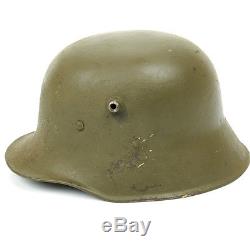
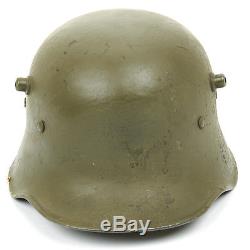
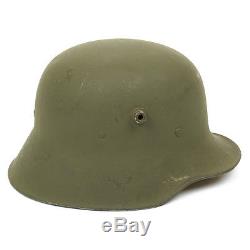
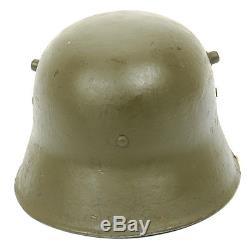
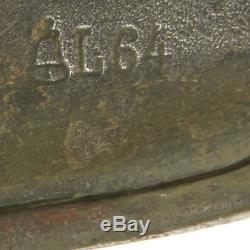
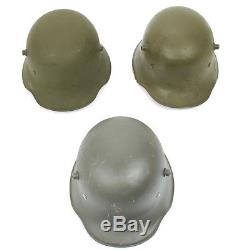
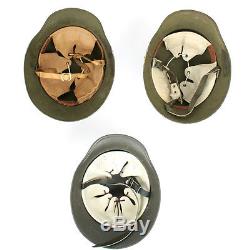
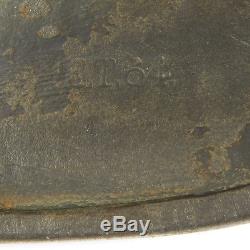
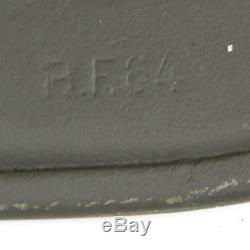
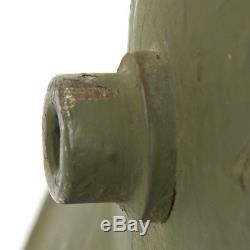
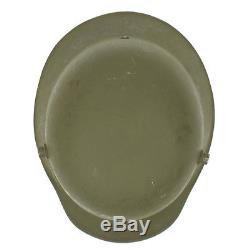
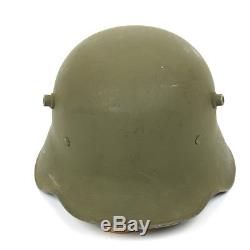

The world leader in military collectibles, military antiques and the militaria industry. Original Imperial German WWI M18 Stahlhelm Helmet - Shell Size 64. 100% authentic WW1 manufacture with maker markings. Sizing- Helmet Shell Size is 64 (liner size 57-58, US 7 1/8 - 7 1/4).
Therefore, the provenance of these amazing nearly 100 year-old, helmets cannot be disputed. What is the difference between an M16, M17 and M18 helmet?
There is no distinction between an M16 and M17 shell. The term M17 refers only to the liner band.
M16 helmets first were produced with leather banded liners and later were produced with M17 steel banded liners. The shell remained the same during this transition. The M18 helmet shell differed from the M16 due to the chinstrap mountings. On the M16 helmet, the chinstrap mounts by means of the same M1891 post mounts as found on early and pre-war pickelhaube spiked helmets. The M18 shell eliminated these M1891 posts and the chinstrap mount was affixed directly to the metal-banded liner.
(In the collecting world, there is much confusion regarding this but actually it is quite simple) Therefore, there are only these three shell models; M16, M18 and the rare M18 "ear cut out". Every German M18 helmet will be 100% original and will have the following notable features. Makers code with size marking 64 stamped on the interior of the shell found over the wearers left ear.
Makers codes vary (see chart below) and all will be genuine WW1! Correct original air ventilation lugs. Dome stamp (under the paint). On the inside dome of every WWI German helmet you will find a heating lot code, these codes were used by the steel factories during production. These steel mills were called rolling mills. Genuine Military issue paint (most likely Finnish), colors will vary. Finnish made leather liner; styles vary between traditional WW1 three-pad type and post war Finnish style. A chinstrap mounted to the liner. Please note these are genuine military issue helmets that were used in two world wars and in military service for more than 40 years. Every helmet will be free of any major issues, but please expect paint imperfections, scratches, minor rust spots, very minor dings or dents, etc. A note on sizing- M1916 liners being a bit more primitive than the later WW2 liners, allow for a wider size tolerance. Meaning simply, bigger heads fit into smaller helmet shell sizes than their WW2 counterparts.In each pad of the liner there is a pocket into which a padded "pillow" can be inserted. As such, helmets are slightly oversize. Without padding, a size 66 helmet shell can fit up to a size US 7 3/4 hat-size.
With the 100-year anniversary of world war one here (August 2014) these helmets, offered in fantastic collectible condition, are a perfect additional to any collection! History of the M16 and M18 Helmet The Stahlhelm was introduced into regular service during the Verdun campaign in early 1916. The M1916 design had side-mounted horn-like ventilator lugs that were intended to be support for an additional steel brow plate or Stirnpanzer, which only ever saw limited use by snipers and trench raiding parties, as it was too heavy for general use. The shell came in different sizes, from 60 to 68, with some size 70s reported.
The suspension, or liner, consisted of a headband with three segmented leather pouches, each holding padding materials, and leather or fabric cords could be adjusted to provide a comfortable fit. The one-piece leather chinstrap was attached to the shell by M1891 chinstrap lugs, the same kind used in the Pickelhaube helmet.
The M1916 design provided excellent protection: Reserve Lieutenant Walter Schulze of 8th Company Reserve Infantry Regiment 76 described his combat introduction to the helmet on the Somme, 29 July 1916: suddenly, with a great clanging thud, I was hit on the forehead and knocked flying onto the floor of the trench... A shrapnel bullet had hit my helmet with great violence, without piercing it, but sufficiently hard to dent it. If I had, as had been usual up until a few days previously, been wearing a cap, then the Regiment would have had one more man killed But the helmet was not without its flaws. The ventilator horns often let cold air in during the winter, requiring the wearer to block the vents with mud or fabric. The large, flared skirt tended to make it difficult for soldiers to hear, distorting surrounding sounds and creating an echo when the wearer spoke.
Originally painted Feldgrau (field grey), the Stahlhelm was often camouflaged by troops in the field using mud, foliage, cloth covers, and paint. Official issue cloth covers in white and grey appeared in late 1916 and early 1917. Camouflage paint was not formally introduced until July 1918, when German Army Order II, No 91 366, signed by General Erich Ludendorff on 7 July 1918, outlined official standards for helmet camouflage. The order stipulated that helmets should be painted in several colors, separated by a finger-wide black line. The colors should be relevant to the season, such as using green, brown and ocher in summer.
Frequently Asked Questions about German WW1 Helmets (courtesy of German Helmets, Inc): Question: How do you determine the size of a WW1 German helmet? Answer: Every WW1 German helmet is marked with a maker and size mark on the inside rim next to the wearers left ear. The maker mark will be a 1, 2 or 3 letter code followed by a number 60, 62, 64, 66 or 68. That number is the size of the helmet in centimeters as measured around the inside dome at the level of the three split-pin holes.Typical markings are ET64, Q66, W66, BF64, K64 and so on. For explanation of the maker marks, refer to the maker chart at the bottom of this page. Question: The maker and size markings are obscured on my WW1 German helmet.
How can I determine the shell size? Answer: Look at the air-vent lugs. Since they were designed to support the brow plate (which was made only in one size) the base of each of the opposing lugs must be the same distance from the other.Since helmet shells were made in different sizes, a "step" was added to smaller helmets in order to make the base of the lugs an equal distance apart. The brow plate rested on that "step" when worn with these smaller helmets.
The higher that "step", the smaller the helmet shell. Question: There are some letters/numbers stamped into the inside dome of my WWI helmet.
Answer: These are accountability numbers which reference specific steel batches from which the planchet came before it was die struck. Intended to aid in quality control at the factory. These numbers have no practical meaning for collectors at this point.
WHAT YOU SEE IS NOT WHAT YOU GET! We display multiple images and write detailed descriptions of the products we sell in order to provide the customer with as much information as possible so you know what to expect when you open the box.
However, most of our original antique items are not one-of-a-kind. Meaning the images you are viewing will not be the exact item that you will receive when you place your order. The images will, however, represent a typical example. In fact, the photos of products displayed on the website are never the very best examples of what we have. We make a concerted effort to photograph average examples of each product. This way, you can expect to receive an item that is at lest as good as the one photographed, unless specified otherwise. The only time you will get the exact item photographed is when an item is listed as one only or one-of-a-kind. However, because so much of what we sell is original antique merchandise there will be some differences between anything photographed and what you receive. Differences are generally minor and can include; markings, dates, size, color, overall condition and more. IMA Inc was founded by Christian Cranmer in 1981. In 2004, his son Alexander joined the business and together (with plenty of help from their magnificent staff) have grown IMA to become the world leader of the Military Collectibles, Military Antiques and the Militaria industry. We offer thousands of military antique items, including very rare original piecesning the past five centuries, as well as hard to find top quality new made reproductions.IMA supplied some of the world's foremost Military Museums, Film Productions (Saving Private Ryan), Collectors, and Re-enactors. However, most IMA customers are just everyday people that happen to share our passion for history. We are an American company with European roots.
Our corporate offices are located in Gillette, New Jersey, less than one hour from New York City. Thank you very much for visiting. Please allow us the opportunity to resolve problems; we understand the concern and frustration you may have and will do our very best to resolve any and all issues. We want to make it easy. You DO NOT need a Return Authorization Number (RA#). Unaltered Condition means that no restoration, painting, major cleaning, or change of any kind has occurred. The return address label provided by IMA is not pre-paid. It is only an adhesive label with our correct address. We appreciate your patience and understanding. Be sure to include a brief note telling us your name, order number (if you have it), explanation as to why you are returning your item. We will resolve your issue before either option is required- that is a promise. We will notify UPS about a pending claim. UPS claims can take up to four weeks, but typically are resolved sooner. We also maintain a secure database of customer addresses. If a mistake was made and IMA is responsible, we will correct it out of our cost. This listing is currently undergoing maintenance, we apologise for any inconvenience caused.The item "Original Imperial German WWI M18 Stahlhelm Helmet Shell Size 64" is in sale since Tuesday, September 02, 2014. This item is in the category "Collectibles\Militaria\WW I (1914-18)\Original Period Items\Germany\Hats & Helmets".
The seller is "international-military-antiques" and is located in Gillette, New Jersey. This item can be shipped to United States, Canada, United Kingdom, Denmark, Romania, Slovakia, Bulgaria, Czech republic, Finland, Hungary, Latvia, Lithuania, Malta, Estonia, Australia, Greece, Portugal, Cyprus, Slovenia, Japan, China, Sweden, South Korea, Indonesia, Taiwan, Thailand, Belgium, France, Hong Kong, Ireland, Netherlands, Poland, Spain, Italy, Germany, Austria, Russian federation, Israel, Mexico, New Zealand, Philippines, Switzerland, Norway, Saudi arabia, Ukraine, United arab emirates, Qatar, Kuwait, Bahrain, Croatia, Colombia.

